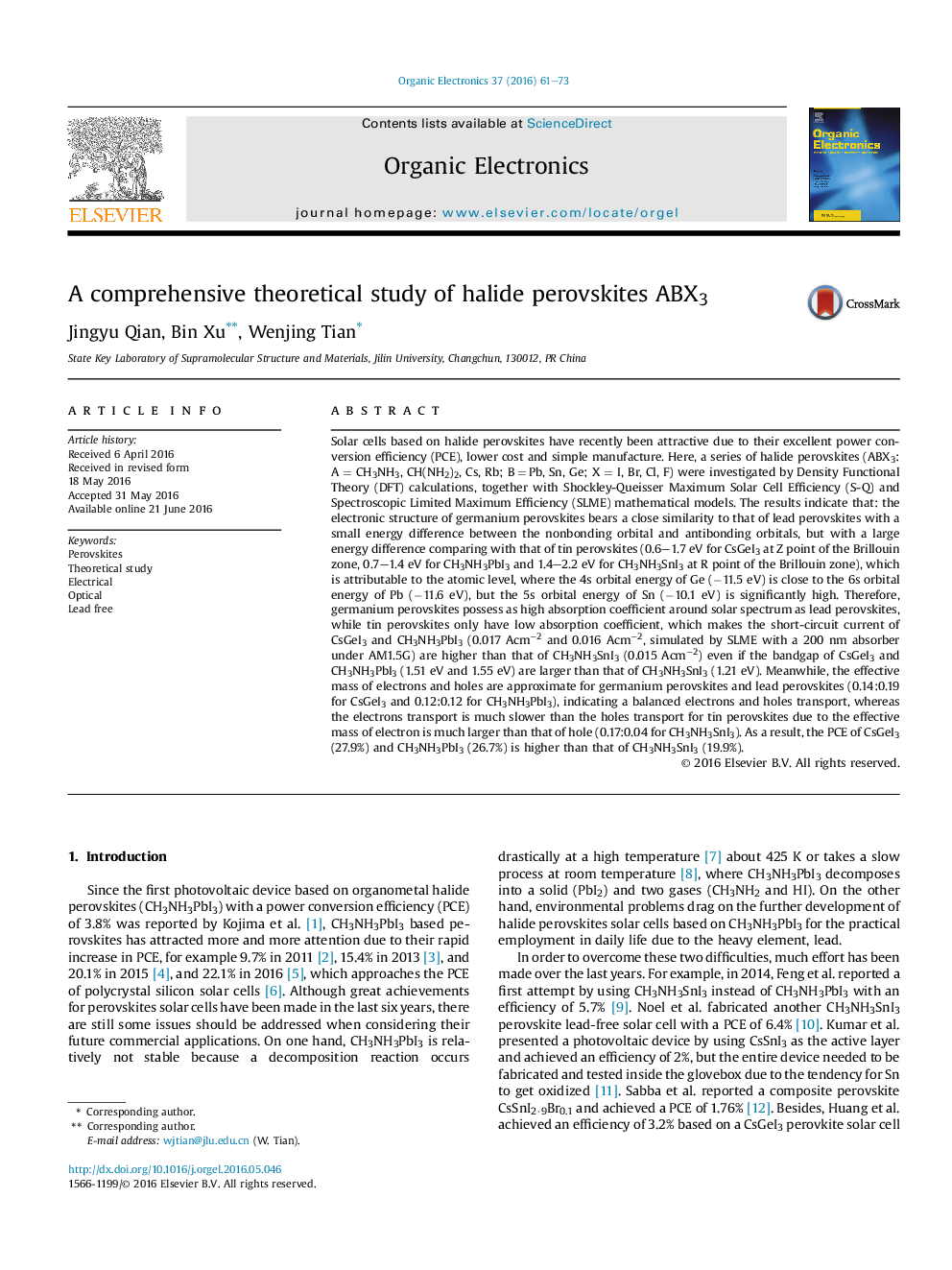| کد مقاله | کد نشریه | سال انتشار | مقاله انگلیسی | نسخه تمام متن |
|---|---|---|---|---|
| 1264657 | 1496820 | 2016 | 13 صفحه PDF | دانلود رایگان |

• The enhanced exchange-correlation energy in halogen decreases the bandgap and increases the PCE of perovskites.
• Ge perovskites possess a similar absorption spectrum and carrier transport properties with Pb perovskites.
• The theoretical PCE of Ge perovskites is close to that of Pb perovskites, and a little higher than Sn perovskites.
Solar cells based on halide perovskites have recently been attractive due to their excellent power conversion efficiency (PCE), lower cost and simple manufacture. Here, a series of halide perovskites (ABX3: A = CH3NH3, CH(NH2)2, Cs, Rb; B = Pb, Sn, Ge; X = I, Br, Cl, F) were investigated by Density Functional Theory (DFT) calculations, together with Shockley-Queisser Maximum Solar Cell Efficiency (S-Q) and Spectroscopic Limited Maximum Efficiency (SLME) mathematical models. The results indicate that: the electronic structure of germanium perovskites bears a close similarity to that of lead perovskites with a small energy difference between the nonbonding orbital and antibonding orbitals, but with a large energy difference comparing with that of tin perovskites (0.6–1.7 eV for CsGeI3 at Z point of the Brillouin zone, 0.7–1.4 eV for CH3NH3PbI3 and 1.4–2.2 eV for CH3NH3SnI3 at R point of the Brillouin zone), which is attributable to the atomic level, where the 4s orbital energy of Ge (−11.5 eV) is close to the 6s orbital energy of Pb (−11.6 eV), but the 5s orbital energy of Sn (−10.1 eV) is significantly high. Therefore, germanium perovskites possess as high absorption coefficient around solar spectrum as lead perovskites, while tin perovskites only have low absorption coefficient, which makes the short-circuit current of CsGeI3 and CH3NH3PbI3 (0.017 Acm−2 and 0.016 Acm−2, simulated by SLME with a 200 nm absorber under AM1.5G) are higher than that of CH3NH3SnI3 (0.015 Acm−2) even if the bandgap of CsGeI3 and CH3NH3PbI3 (1.51 eV and 1.55 eV) are larger than that of CH3NH3SnI3 (1.21 eV). Meanwhile, the effective mass of electrons and holes are approximate for germanium perovskites and lead perovskites (0.14:0.19 for CsGeI3 and 0.12:0.12 for CH3NH3PbI3), indicating a balanced electrons and holes transport, whereas the electrons transport is much slower than the holes transport for tin perovskites due to the effective mass of electron is much larger than that of hole (0.17:0.04 for CH3NH3SnI3). As a result, the PCE of CsGeI3 (27.9%) and CH3NH3PbI3 (26.7%) is higher than that of CH3NH3SnI3 (19.9%).
Figure optionsDownload as PowerPoint slide
Journal: Organic Electronics - Volume 37, October 2016, Pages 61–73